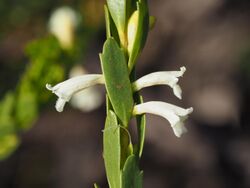Biology:Eremophila compressa
| Eremophila compressa | |
|---|---|

| |
| E. compressa growing near Salmon Gums | |
| Scientific classification | |
| Kingdom: | Plantae |
| Clade: | Tracheophytes |
| Clade: | Angiosperms |
| Clade: | Eudicots |
| Clade: | Asterids |
| Order: | Lamiales |
| Family: | Scrophulariaceae |
| Genus: | Eremophila |
| Species: | E. compressa
|
| Binomial name | |
| Eremophila compressa Chinnock[1]
| |
Eremophila compressa is a flowering plant in the figwort family, Scrophulariaceae and is endemic to a small area in the south west of Western Australia. It is an erect shrub whose leaves have 2 or 3 prominent teeth near their ends, and white or cream-coloured flowers.
Description
Eremophila compressa is an erect, open shrub which usually grows to between 0.8 and 2 m (3 and 7 ft) high with branches that are glabrous but have many warty lumps and are sticky towards their ends due to the presence of resin. The leaves are arranged alternately and point upwards so that they often obscure the branches. They are green, often with a purple tinge, elliptic to egg-shaped, mostly 8–16 mm (0.3–0.6 in) long, 2–7 mm (0.08–0.3 in) wide, and have 2 or 3 prominent teeth near their ends.[2][3]
The flowers appear singly or in pairs in leaf axils on stalks 1–3.5 mm (0.04–0.1 in) long. There are 5 narrow triangular, glabrous green sepals, 1–2 mm (0.04–0.08 in) long. The petals are 6–10 mm (0.2–0.4 in) long and joined at their lower end to form a tube. The petal tube is white to cream-coloured, glabrous on the outside but the inside of the tube is filled with long soft hairs and the top of the bottom lobe is also hairy. The 4 stamens are fully enclosed in the petal tube. Flowering occurs mostly from July to December and is followed by fruits which are oval-shaped, glabrous and about 1 mm (0.04 in) long.[2][3]
Taxonomy and naming
The species was first formally described by Robert Chinnock in 1986 and the description was published in Nuytsia.[4] The type specimen was collected by Chinnock north of Salmon Gums.[2][4] The specific epithet (compressa) is a Latin word meaning "compressed"[5] referring to the compressed shape of the fruits.[2]
Distribution and habitat
This eremophila occurs between Ravensthorpe, Grasspatch and Norseman[2][3] in the Esperance Plains and Mallee biogeographic regions[6] where it usually grows in disturbed clay or sandy loam soils.[2][7]
Conservation status
Eremophila compressa is classified as "Priority Three" by the Government of Western Australia Department of Parks and Wildlife,[6] meaning that it is poorly known and known from only a few locations but is not under imminent threat.[8]
Use in horticulture
In cultivation this eremophila grows to 2 m (7 ft) high and almost as wide. It flowers over a long period and its open, spindly growth form is a feature. It can be propagated from cuttings or by grafting onto Myoporum species, grows in most soils in full sun or partial shade, is frost tolerant and reasonably drought resistant.[9]
References
- ↑ "Eremophila compressa". Australian Plant Census. https://biodiversity.org.au/nsl/services/apc-format/display/113016. Retrieved 10 April 2020.
- ↑ 2.0 2.1 2.2 2.3 2.4 2.5 Chinnock, R.J. (Bob) (2007). Eremophila and allied genera : a monograph of the plant family Myoporaceae (1st ed.). Dural, NSW: Rosenberg. pp. 187–188. ISBN 9781877058165.
- ↑ 3.0 3.1 3.2 Brown, Andrew; Buirchell, Bevan (2011). A field guide to the eremophilas of Western Australia (1st ed.). Hamilton Hill, W.A.: Simon Nevill Publications. p. 66. ISBN 9780980348156.
- ↑ 4.0 4.1 "Eremophila compressa". APNI. http://id.biodiversity.org.au/name/apni/113016. Retrieved 2 January 2016.
- ↑ Brown, Roland Wilbur (1956). The Composition of Scientific Words. Washington, D.C.: Smithsonian Institution Press. p. 630.
- ↑ 6.0 6.1 "Eremophila compressa". FloraBase. Western Australian Government Department of Parks and Wildlife. https://florabase.dpaw.wa.gov.au/browse/profile/7191.
- ↑ Paczkowska, Grazyna; Chapman, Alex R. (2000). The Western Australian flora : a descriptive catalogue. Perth: Wildflower Society of Western Australia. p. 334. ISBN 0646402439.
- ↑ "Conservation codes for Western Australian Flora and Fauna". Government of Western Australia Department of Parks and Wildlife. https://www.dpaw.wa.gov.au/images/documents/plants-animals/threatened-species/Listings/Conservation%20code%20definitions.pdf. Retrieved 2 January 2016.
- ↑ Boschen, Norma; Goods, Maree; Wait, Russell (2008). Australia's eremophilas : changing gardens for a changing climate. Melbourne: Bloomings Books. pp. 78–79. ISBN 9781876473655.
Wikidata ☰ Q15593600 entry
 |



